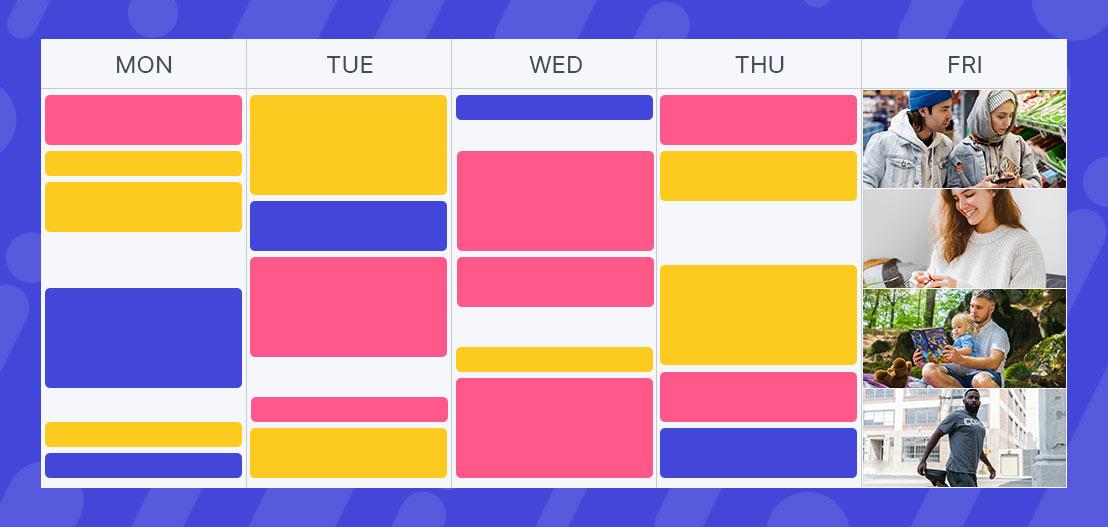When companies shifted to remote work during the pandemic, business leaders started rethinking their priorities regarding flexible work arrangements. And the most transformative work concept to gain momentum out of all this is the four-day work week.
The movement, which first gained traction in Iceland and Japan a few years ago, is gaining steam here in America. Dozens of American companies have
already made the switch, and dozens more are currently piloting the concept. Not surprisingly, employees are enthusiastic about the idea. In a 2022 poll, 92% of
respondents said they support the shorter week, prompting CNBC to declare the four-day work week inevitable.
However, despite all this good press, many business and HR leaders understandably have questions and concerns about how feasible it really is. They wonder:
- Won’t my customers (and business) inevitably suffer?
- How can we possibly be as productive with a shorter schedule?
- Will recruiting and retention benefits really outweigh the potential drawbacks?
The good news is that enough companies have now made the transformation that some battle-tested best practices are emerging. At the same time, it’s also clear that there’s no single “right” way to design a four-day work week. There are a variety of ways to solve common problems. And even if you ultimately decide the leap to a shorter week isn’t right for you, there’s enormous value in auditing your company to see how you might work more efficiently and provide greater work-life balance to your employees.
In this first-of-its-kind guide we’ll share what we (Wonderlic) and five other early adopters have learned about how to:
- Determine if a four-day work week is realistic for your company
- Think through all the critical planning questions
- Plan and conduct a successful pilot
- Analyze pilot data and make a decision
- Ensure your new policy’s long-term success
What we’ll cover
Here’s a breakdown of this guide:
1. The benefits of a four-day week
2. The potential challenges of a four-day week
3. What to do before you start a pilot
4. How to run an effective pilot
5. How to “make it official”
6. How to optimize for long-term success
7. A final note from Wonderlic CEO, Becca Callahan
Meet our experts

Victoria Bacon
Community Engagement Manager (formerly HR Manager), PDQ
Company
150+ employees | Software company
Type of Four-Day Work Week
A 36-hour, four-day week with a one-hour lunch; employees choose their schedule: 6:30 AM – 3:30 PM or 8:30 AM – 5:30 PM

Banks Benitez
Founder & former CEO, Uncharted
Company
<100 employees | Software company
Type of Four-Day Work Week
A 32-hour, four-day week with Fridays off; employees are required to be available between 10 AM – 3 PM with their remaining three hours flexible

Josh Berthume
CEO & President, Swash Labs
Company
<50 employees | Ad agency
Type of Four-Day Work Week
A 32-hour, four-day week with staggered schedules within departments to ensure Monday –Friday coverage

Becca Callahan
CEO, Wonderlic
Company
<100 employees | HR tech company
Type of Four-Day Work Week
A 32-hour, four-day week, with most employees off on Fridays, with the exception of the customer support and sales teams, who alternate Mondays and Fridays to ensure all-week coverage

Adam Ross
CEO, Awin
Company
~1,200 employees in 15 countries | Media company
Type of Four-Day Work Week
A 32-hour, four-day week that allows employees to take off whatever day they prefer

Arthur Shectman
CEO, Elephant Ventures
Company
<100 employees | Software company
Type of Four-Day Work Week
A 40-hour, four-day week with Fridays off for most employees

The benefits of a four-day week
All of the experts we talked to decided to stick with a four-day week after their pilots for a reason. Here are some of the benefits they’ve seen so far.
A huge recruiting and retention advantage
Despite growing interest in shorter work weeks, the number of American companies that have actually followed through on a four-day work week is still very small. All six of the experts we talked to said their company had seen a boost in either talent attraction, retention, or both after making the switch.
When Awin introduced a shorter week in early 2021, candidate applications were up 12% compared to the same quarter in the previous year. At the same time, employee churn rates also decreased, with 2021’s figures being the lowest in company history. According to Arthur Shectman, CEO of Elephant Ventures, a shorter work week has “definitely had a positive impact.” Since instituting the change, his company has grown 41%, doubled profit margins, and seen more inbound submissions from top talent than ever before.
Wonderlic’s CEO Becca Callahan says the company has seen “extremely substantial increases” in applicant volumes—and that the four-day week has enabled the company to compete with the Amazons and Facebooks of the world, as well.

While companies from Silicon Valley can offer our employees higher compensation and benefits, we still beat them on culture. It’s been meaningful to see a lot of those employees say, ‘No, I’d rather stay here.’
– Becca Callahan, CEO of Wonderlic
Other smaller companies without the deep pockets bigger companies have echoed that sentiment:

If you can’t be in the 1% salary, you can still be in the top 1% of work weeks.
– Banks Benitez, former CEO of Uncharted
Happier, more focused employees
The 4 Day Week Global Foundation reports that 78% of employees with four-day work weeks are happier and less stressed, and these findings rang true to the employee feedback our experts have received as well.
According to Callahan, Wonderlic employees have shared that they now have more time to explore hobbies, catch up on errands, and pursue their personal goals, such as higher education and artistic endeavors.
Feedback from managers and the results of engagement surveys, Callahan says, have also made it clear that a shorter work week has made employees more focused and engaged so they can get high-quality work done in less time. Also, the tighter schedule has organically led to people learning how to make better, faster decisions.
Additionally, companies have seen significant reductions in absenteeism and higher overall engagement scores since making the move.

Staff absence for the first quarter of 2021 fell by a massive 59% compared to the same period in 2020 and by 29% compared to the first quarter in 2019. As well as a fall in absence, results from our staff survey have revealed there has been a 12.8% rise in employee engagement. Meanwhile, staff also determined themselves to be 9% more productive during February 2021 when compared to the same month in 2020.
– Adam Ross, CEO of Awin
Support DE&I efforts
Moving to a shorter week isn’t only about giving employees more work-life balance and supporting recruiting efforts. It can also support your efforts to build a more diverse and equitable work culture.
Systemic oppression and societal norms place caregiving duties disproportionately on women—and even more disproportionately on women of color. Nearly 2.1 million women left the labor force in 2020, including 564,000 Black women and 317,000 Latinas, according to the National Women’s Law Center.
If your company wants to make it easier for workers with significant caretaking duties to work outside the home, and relieve some of the financial strain required to provide childcare while they work, implementing a 4-day work week (especially in a remote work environment) can make a material difference. As Banks Benitez notes: “If you have small kids, having Fridays off is like a 20% reduction in childcare.”
Becca Callahan also notes that giving people an extra day off can help create more balance at home with caregiving and household chores.

I’ve heard many working parents talk about how having an extra day off has led to a more equitable and balanced share of the parenting load. The working parent gets more time than usual with their kids, and the primary caregiver gets a much-needed break.
– Becca Callahan, CEO of Wonderlic
More empowered employees
Reimagining the work week isn’t just a matter of subtracting hours and compressing the work. The shift has the potential to transform the fundamental relationship between managers and direct reports for the better.
According to Banks Benitez, in order to come up with a fair plan for executing 40 hours of work in 80% of the time, managers need to trust their direct reports’
assessments of how much effort and time projects will really take—and which tasks are truly essential. Likewise, senior leadership needs to trust managers to manage their resources wisely to make sure critical work gets done on time.
When this shift is made, Benitez says, “Employees have the language to be strategic and to hold you as leadership accountable.” He adds, “In some ways, it really shifts power, and it also creates more equitable workplaces.”
In short, by empowering employees to identify and eliminate time-wasting tasks in order to focus on the work that is most critical to their team’s success, companies organically create a flatter org structure, and give all their employees a sense of ownership over the continued success of their shorter week.

The potential challenges of a 4-day week
While the overwhelming majority of employees prefer the 4-day week, there are trade-offs worth noting.
Less face time can potentially affect team bonding
Paring down schedules to focus only on the essential tasks can lead to less facetime among teams. There are fewer opportunities for both organized team-building and the types of casual conversations unrelated to work that can help employees build relationships. In fact, one Gallup study found that while four-day workers report better well-being and less burnout, many reported slightly higher levels of disengagement.
To promote team bonding even on a tight schedule, Elephant Ventures earmarks the first few minutes of every meeting for socializing and casual conversation. For the same reasons, PDQ schedules regular company-wide break times, where employees can drop what they’re doing, grab a beverage (alcoholic or not), and hang out.
Reduced time with managers
To protect the time they need to get mission-critical work done, managers might be tempted to block off more time on their calendars as “unavailable” than they did
previously. However, this mentality can potentially lead to direct reports not getting the amount of face time they want—and need—from those managers. At Uncharted, the leadership team solved this problem by asking managers to build in buffer time to their calendars so their direct reports had adequate opportunities to interact.
Increased deadline-related stress
The prospect of having to do the same amount of work in 80% of the time may intimidate and stress out some employees at first.
But this is an opportunity for management to audit workloads and make changes. For example, when Awin started a 4-day week, people initially struggled with workloads. So management worked to resolve this issue by analyzing and distributing work in a more fair way, investing in a workplace management tool, automating tedious tasks, and cutting down on time-wasting in meetings.
In particular, people who are prone to perfectionism may struggle under the pressure of a compressed timeline, says Uncharted’s Banks Benitez. He recommends dealing with this by providing training and messaging from management that emphasizes how to distinguish between important and unimportant tasks. He explains that prioritizing work has always been part of any employee’s skill set, and now it’s more essential than ever.

You have to be prepared to close your laptop knowing that you didn’t get all your work done but you got your most important work done.
– Banks Benitez, former CEO of Uncharted
So, yes—there are clearly challenges to be aware of, as you’re considering this move. But our experts have found they are all manageable—and as long as you proactively manage expectations, help employees with time management, and prioritize face time, the rewards significantly outweigh the risks.

What to do before you start a pilot
All of our experts ran a pilot before they committed to a shorter week—of lengths as short as 10 weeks (Wonderlic) and as long as 18 months (Awin, which is still officially in pilot mode).
We asked them to share the questions they feel are most critical to ask before initiating a pilot, and what they would have done differently knowing what they know now. Here’s some of the advice they gave.
Decide early how you’ll meet the support needs of your customers and partners
Understandably, many business leaders’ first concern regarding a shortened work week is the negative effect it might have on their customers and partners. So it’s important to think through the accommodations likely to be most tolerable to those groups.
Audit when customer support needs are heaviest
Specifically ask:
- When is customer call volume the highest?
- Are there times of the week, or the month, or the year when support requests are more urgent than others?
- What have customer expectations regarding response times been during any prior company-wide shut-down periods?
Wonderlic decided to eliminate Fridays as opposed to Mondays, after identifying the client expectations for follow-up were lowest right before a weekend or a holiday; hence, Fridays were an easier “day to miss” than Mondays.
It’s also okay to modify the schedule based on seasonal needs. Awin, for example, has “peak weeks,” in which managers can tell their team that they need them to work five days per week for a six-week burst, such as the finance team at year-end or client-facing teams during the holiday shopping season. This type of flexibility works, as long as you set expectations in advance.
Run a similar analysis of your partners’ needs and expectations
If you’re evaluating the effect on partners, take a look not only at response time expectations—but also when periods of collaboration tend to be the most intense.
If you’d like some external feedback early, consider doing what Art Shectman of Elephant Ventures did: send an email to a core group of customers and partners early on to take their temperature on your consideration of a shorter week, and to explain your plans for delivering the same high-quality end product they’re used to.
After your audit, decide on the best way to accommodate both groups
Most of the experts we consulted maintain 5-day-a-week customer and prospect coverage by staggering the schedules of certain teams. For example, Wonderlic asks sales reps and customer support team members to work one Friday a month, and gives them a Monday off in return. At PDQ, some people work Tuesday through Friday, and some work Monday through Thursday. Elephant Ventures occasionally drops its usual Monday-Thursday schedule to meet a core client’s needs.
One thing worth noting was that, across the board, our experts told us that while they were very concerned about how their decision to pilot this schedule would be
received, they were pleasantly surprised at how supportive their clients were, once they shared their intentions.
Decide on the specific type of four-day week
As we mentioned earlier, there are a variety of ways to set up a four-day work week. But at a high level, you’ll first want to decide whether you’re going to ask your employees to still work 40 hours, spread over 4 days, or whether you’re going to reduce the workday to 32 (or 36) hours. The latter model, subscribed to by Andrew Barnes, author of The 4 Day Week, is sometimes described as the 100/80/100 model, in which staff receive 100% of their contractual compensation and only need to work 80% of the time, provided they deliver 100% of the agreed-upon productivity.
The former could minimize the stress some employees feel about the pressure to improve efficiency and maintain production in less time. But 10-hour days can also potentially create conflicts with people’s existing personal schedules. The latter, more common, approach requires the ability to accomplish tasks more efficiently, but potentially could be a bigger draw to candidates, and lead to higher engagement scores.
There are various ways to approach which days people can take off, too. Most companies do Fridays off, but at Awin, any day goes; at PDQ, some people take
Mondays or Wednesdays off, and as we mentioned, at Wonderlic, we mostly work Monday to Thursday, with employees in our most public-facing departments taking turns covering Fridays.
Decide on the finer details of your pilot
Now that you have decided that the shorter week might be an option for your business and you’ve decided on the overall schedule, you have a few additional questions to ask yourself and your decision makers.
What is the key goal of the pilot?
The main goals of your pilot may seem obvious to the core group of stakeholders. But take the time to get alignment on which outcomes really matter the most and write them down. Doing so will help you assess the success of the pilot with more confidence.
Think about the ideal employee experience you’re looking to deliver. Then ask yourself which adjustments get you closest to that target—and which adjustments are viable but might compromise the original intent in a way that makes it a non-starter.
At Wonderlic, our primary goal was employee-experience-related: we wanted to give one extra weekend day to the entire company, both to reduce burnout and to enable them to have more options for enjoying their weekends. Every tactical decision we made during our pilot was influenced by that north star.
How will you measure success?
Decide well in advance how you’ll measure success—and collect as much baseline data as you can before you start the pilot, so you have something solid to compare new data against.
You’ll likely want to track and compare:
- Key financial performance indicators (KPIs)
These might include sales figures, gross revenue, and EBITA (Earnings before interest, taxes and amortization) data - Customer satisfaction
Comparing your Net Promoter Score (NPS) from before the pilot and after, for example, provides a useful metric for customer service; also don’t discount qualitative data (feedback from customers in emails and phone calls) - Overall productivity
How this is measured may vary by team—and is likely best determined by managers. Engineering teams, for example, might measure success in terms of meeting project milestones on schedule, whereas a sales team may measure cold call volume, meetings held, and so on. - Employee engagement
Send surveys to employees before you even announce the pilot, in the middle of the pilot, and then again after the pilot. Your survey should go far beyond asking “Do you want a shorter week?” and instead include questions that help quantify overall sentiment.
Ask employees to rate their feelings about the pilot on a scale of 1–5. Decide what approval rating merits a green light. For example, Elephant Ventures felt that a strong majority of employees–80% or higher–would have to approve the new schedule in order to move forward. Also, consider tracking the types of reviews your company is receiving from current employees on review sites like Glassdoor.
Who will project manage the pilot?
All the legwork related to the pilot shouldn’t have to fall entirely on the small group of leaders who decided to implement it.
Consider creating a pilot task force of people from various departments with different competencies to assist in gathering and aggregating feedback,
brainstorming solutions to challenges that emerge, and championing the effort internally. You might tap a group of managers exclusively or a combination of managers and individual contributors.
Involving a group that’s representative of the whole company at this stage will help you identify challenges and potential solutions you might not have anticipated and send the message that ownership for the success of a potential four-day week is shared by everyone at the company.

Running a successful pilot at this scale requires a great deal of preparation and engagement from a large group of people. If you’re an international organization like us, you need champions in every territory because of different laws, jurisdictions, and rules. To help set the foundation to make this successful, we set up multiple task forces, with about 80 people involved in total—and they’re still helping us refine our approach today.
– Adam Ross, CEO of Awin
How long should you run your pilot?
In surveying our experts, we found there were two overall philosophies to pilot length: run the pilot for roughly a quarter…or stay in pilot mode for at least a calendar year to see how changes in seasonality might affect things.
It’s also worth noting that some companies planned to have a longer pilot and saw such early success that they ended the pilot early to make the policy official—and some intended to have a shorter pilot, but then extended it because they felt they needed more feedback.
So regardless of how long you decide to run your pilot, remember that you’re allowed to change the plan on the fly, if necessary.
What tools and technologies might help your employees work more efficiently and productively?
It may seem daunting to reduce your work hours by 20%, but there’s likely more slack in a traditional five-day work week than you realize. In fact, in one recent study, British workers reported being productive only 2.5 hours per day.
Also, keep in mind that your company has already figured out ways to work with the constraints imposed by holiday work weeks, summer hours, and parental leave coverage. So you may already have some unofficial best practices at hand you could implement in a four-day week.
Here are a few ways our experts suggested adjusting company policies, processes, and project management approaches to reduce busywork and distractions:
- Start by making hour-long meetings 45 minutes long, then see if they can be further cut to 30 minutes
- When you do have meetings, include short agendas and goals to keep people on track
- Encourage more asynchronous communication such as email and Slack check-ins
- Adopt project management software such as Asana, Trello, or Basecamp
- Institute “deep work” times so employees get used to practicing sprints, or concentrated hours with no meetings or interruptions so they can focus on important tasks or getting the maximum work done during busy seasons
- Continue offering the remote work options you likely rolled out during the pandemic. Studies show that remote workers are more productive because they have fewer work distractions.
If you’re a company considering some sort of reduction of your work week, you probably don’t need to hear this, but our experts all strongly discouraged using draconian productivity monitoring tools that track keyboard strokes, and employees’ active and idle time on certain applications or sites. Doing so will likely erode the mutual trust all our experts say is necessary to make this approach successful.
Will you change PTO policies?
You may want to adjust your paid time off policies to align with the new schedule and ensure balanced coverage throughout the year.
For example, Awin doesn’t allow three-day weeks. If a holiday creates a four-day week, that holiday is considered the employee’s weekday off. At Wonderlic, we changed our PTO accrual policy to encourage people to use more PTO earlier in the year in order to avoid everyone taking time off simultaneously at the end of the year, which is more likely to happen with a four-day week.
How will you prioritize professional development?
Companies that transition to the four-day week have to reconsider their policies on professional development. For example, if you previously allowed employees time to take classes during work hours, this may not be possible with a shorter schedule. Be sure to communicate the expectation, such as saying “course work should be completed outside of the 32-hour work week.”
How will you talk about the pilot with job applicants?
Consider how you’ll talk (or not talk) about the experiment you’re running in job ads, and during the recruiting process. You don’t want to bait and switch anyone if it doesn’t pan out.
When PDQ ran a four-day trial, their pilot lasted a full year. During this time, they continued to hire new employees but they didn’t advertise the shorter work week. Instead, at the end of the hiring process, they told new employees the good news about their pilot schedule.

It was like giving somebody a Christmas present. It was like they just won on The Price is Right.
– Victoria Bacon, former HR Manager of PDQ

How to run an effective pilot
Careful preparation will set you up for a successful pilot, but refining your approach will likely require taking an iterative approach to solving problems, and optimizing processes while the pilot is in progress. Here are a few things to consider as you dive in.
Announce your intentions to the company well in advance
At least a month before you launch the pilot, officially announce your plans to the company at large, beyond the initial champions and task force. This will give managers and their direct reports ample time to start preparing for the change.
Managing expectations up front is crucial. Frame the pilot as an experiment, not as the inevitable ramp up to a new normal. Be transparent about the benefits you’re hoping it will deliver to the whole company, and the ways you’ll be determining whether making the transition is viable for your company.
Explain how you’ll be gathering feedback, what you’re looking for in particular, when you expect to know whether you’ll go forward.
And make it clear you’re open to suggestions at any point during the pilot experience.

I’d recommend framing your four-day work week experiment as one possible means to the goals you’ve set for it, not the end in itself. This will signal clearly to your employees that if making the leap isn’t actually possible, you’re still committed to exploring other options to improving their work life.
– Becca Callahan, CEO of Wonderlic
Announce your intentions to your partners and customers
Just as you would prepare for a sales pitch, work with managers to brainstorm other potential objections that your clients and partners might have that your initial task force might not have foreseen.
Then, proactively reach out to clients and explain your plan for solving those potential issues before they arise. Obviously, make clear that you’re only piloting the
idea, not instituting it permanently. And reassure them that they shouldn’t see any degradation in the service they receive—and encourage them to come to you directly with any feedback.
Review and adjust to feedback regularly
As we mentioned earlier, consider polling employees at least three times—at the beginning of the pilot, halfway through, and at the end. (If you run a year-long pilot,
you’ll likely want to increase this number considerably.) Weigh the potential benefits of anonymous feedback (more, and more honest, feedback) against more transparent feedback (a clearer sense of team-specific or personality-specific concerns).
Schedule time for important decision makers to meet regularly to share and discuss feedback as it comes in.
Most importantly, make adjustments on the fly as needed. The goal of your pilot is to find out which elements of this experiment work best for your company, and the
best way to find out is to have an iterative design mentality that assumes you won’t get it right on the first try, and builds in multiple opportunities to make improvements.
Assess the pilot—and make a decision
A few weeks before the end of the pilot, assess the data you’ve gathered (both quantitative and qualitative).
Keep all of your goals top of mind, not just your central goal.
Then, gather all your insights and review your original plan for measuring success and compare your results. Did you hit your benchmarks? Which ones were reached
or exceeded, and which weren’t not quite met? Were there any surprises? Systematically look at how the results sync up with your main goals.
After doing all that, it’s time to make a decision. But don’t think in terms of all or nothing:

You may feel confident and decide to move forward with the implementation.

You may feel you need to take another swing before committing and extend your pilot.

You might decide a four-day week isn’t actually a good fit for your organization, and that’s okay too.
If you choose option 3, don’t just fall back into your status quo, however. Discuss whether there are more moderate goals within reach or different methods of moving toward your original goal. Consider offering other work/life balance benefits your employees will appreciate, like:
- One Friday off a month, instead of every week
- No-meeting Fridays
- Extending summer hours by a month
- Instituting deep work periods so people can get in a flow and avoid constant context switching

How to “make it official”
It’s important to be as strategic about communicating whatever change you’ve decided to make as you were in designing and executing the pilot. Here are three steps you shouldn’t skip.
Communicate thoughtfully to employees, customers, and ownership or the board
The announcements should emphasize the fact that you’ve found an implementation that sufficiently satisfies your original goals. Send a mass email to all customers, ideally coming from your CEO. Consider recording a short video explaining the move and including it in the email. Equip customer service teams with talking points about why you’re making the change, and preemptively answer any concerns about availability.
Tell the world beyond your inner circle
Next, announce the news to the world. This is an obvious opportunity to recruit new talent, but there are also longer-term marketing benefits because your brand will now be associated with pioneering a new, more progressive kind of workplace. Whether you work with a public relations firm or handle PR internally:
- Draft a press release with quotes from leadership and use a PR wire service to distribute it.
- Share the news on all your company’s social media platforms
- Encourage the CEO, head of HR, and other leaders to share their own posts endorsing the exciting announcement.
- Provide employees with ready-made language (and hashtags) they can use as a foundation for their own posts as well; the more people share this exciting announcement, the better.
Update your website, recruiting content, and internal policies
Lastly, mention this incredible new benefit in your job descriptions and the Careers and About Us pages of your website. And don’t forget to update employee manuals, agreements, and other relevant internal documents to reflect the policy change.

How to optimize for long-term success
As your company and the world of work changes, be on the lookout for new ways to make your four-day week deliver on the goals you intended for it.
Reach out to the four-day week community
Remember, you’re not alone in this effort to adopt a new way of working. There’s a growing community of four-day week companies. Consider connecting with other business leaders that are leading the way with four-day weeks and getting involved with 4 Day Week so you don’t feel like you’re in a bubble.
Consider the employee characteristics that align best with four-day week success
Commitment from leadership and strong organizational structures are important to making a four-day approach work. But the long-term success of your shorter week will ultimately depend on the performance and the happiness of your workforce.
So as your company designs recruiting and employee development strategies, take stock of the work-related competencies or characteristics that seem to correlate to successfully handling a shorter work week.
When we asked our experts which characteristics seemed to correlate with success, four stood out:

A focus on outcomes over process
“It’s absolutely critical, this idea of being outcome-focused. We’re not interested in any idea of presenteeism, people needing to be seen working hard, or being seen as close to the senior people in the organization.”
— Adam Ross, CEO of Awin

Dependability & time-management skills
“There’s a bunch of discipline needed in terms of timeliness and your calendar management and sort of maintaining the intensity of the work day. So we look for very disciplined, very dependable people. Types that when they say they would get a thing done, it gets done. Not employees that need the “didya-do-it” police to get things done.”
— Arthur Shectman, CEO of Elephant Ventures

Strong communication and collaboration skills
“We’ve found that if you’re truly working collaboratively and communicating what you need from each other, you’ll find ways to get everything done, and make sure you have coverage every day of the week.”
— Victoria Bacon, former HR Director of PDQ

The ability to prioritize
“You have to prioritize about how to leave things undone and ask what your relationship is to incompleteness. Are you okay closing your computer on Thursday night knowing that you didn’t get all your work done but knowing that you got your most important work done?”
— Banks Benitez, former CEO of Uncharted
On the recruiting front, using pre-employment assessments focused on measuring stable competencies (like cognitive ability, motivation, and personality) can help provide a picture of whether your candidates are strong in these areas or not.
And if you feel your existing workforce could benefit by improving in these areas, consider offering development resources that both give employees awareness of their strengths and weaknesses, and practical recommendations for improvement.
Keep a feedback loop going, long-term
Even if you feel like you’ve landed on a four-day formula that works well, invite employee feedback on a regular basis about what’s working or not. Specifically ask questions like:
- Do you feel you’re being asked to do an unreasonable amount of work assigned for four days per week?
- Is the accelerated atmosphere creating undue stress? What might the company do to improve the situation?
- Do you feel you have enough face time with other members of your team? If not, what recommendations might you make?
If you ran a shorter pilot, make sure to ask these questions at least through the first full calendar year, so you’re accounting for any seasonal variables you hadn’t anticipated.
But above all, keep in mind that just as a 40-hour, five-day work week isn’t written in stone, neither is your initial design of a four-day week. As long as you’re meeting your company goals, and your employees and customers are happy, you really are free to create whatever work culture you want.

We decided to make it policy, but really the four-day work week is a fitness. It’s like if you go to the gym you buy a gym membership, but that doesn’t make you fit. It’s a fitness that we continually practice as an organization, and I tell people let’s continually apprentice ourselves in the direction of a four-day work week every single week.
– Banks Benitez, former CEO of Uncharted
A Final Note from Wonderlic CEO, Becca Callahan
Hi there!
I sincerely hope you found this guide useful as you consider making changes at your company. I know we learned a lot ourselves by talking with Josh, Victoria, Art, Adam and Banks about their own experiences as early adopters of this new approach to work.
As of the release of this guide, Wonderlic has been doing a four-day week for about a year, if you include our summer pilot. In that time, we’ve measurably increased employee engagement while maintaining our pre-2021 productivity levels, met our revenue goals, and recruited (and retained) some incredibly talented employees we might not have been able to before we made the move. With their extra free time, our employees have told us they’re spending more time with their families, exploring new personal passions, and feeling more refreshed by the time Monday rolls around again.
I want to acknowledge that as a small SaaS technology company we’re in a privileged position to be able to explore and test the feasibility of this model. Without more systemic societal changes and supporting legislation, there may be industries and sectors where a four-day work week isn’t yet possible.
In the meantime, however, we’ll continue to champion this new model for work, and offer any guidance we can to employers considering the change.
Thanks for your time and best of luck!

— Becca
Wonderlic’s mission is to help HR professionals and hiring teams identify top applicants and predict on-the-job performance by providing them the most trusted, scientifically validated assessments on the market. Since the company was founded in 1937, more than 200 million Wonderlic assessments have been administered to job candidates.
Learn more about our decision to shift to a four-day week.
Find out more about how Wonderlic is helping identify high-potential talent for millions of jobs, at companies with every kind of work culture.









